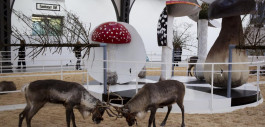
INS 027 SOMA Carsten Höller 2010
Header image:
Hamburger Bahnhof, Berlin
© DAPD, Maja Hitij
Text I: Hamburger Bahnhof Berlin
Text II: designboom
How do we achieve enlightenment? What role is science given in our society, and what role myth? Do we need to find alternative categories for experience and alternative approaches to awakening consciousness? These questions are all raised by the artist Carsten Höller in his show in the Hamburger Bahnhof, Museum für Gegenwart Berlin.
As one enters the former railway station, they are greeted by the sounds of singing canaries, whose songs fill the hall, the faint smell of farm stables lingering in the air. These sensory impressions, hardly what one would expect within a museum space, create a fantastical scenario that will slowly unfold over the course of the winter months. Set against this backdrop, Höller has devised a scene that stands at the crossroads between art and science, laboratory and dream, supposed objectivity and heightened subjectivity…
Within the exhibition, Höller explores the myth of "soma" — a drink with healing properties known among verdic nomads in north India in the second millennium BCE that promised enlightenment and access to the divine sphere. Commonly used in rituals, the drink’s main ingredient is no longer exactly known to us; ethnomycologists and philologists generally posit the fly amanita mushroom (Amanita muscaria) as the substance responsible for its effects. In 1968, Gordon R. Wasson, American wall street banker by profession with a passion for mycology, published a compendium, citing the fly amanita mushroom as the sought-after soma plant.
The protagonists of the scene include twelve reindeer, twenty-four canaries, eight mice and two flies, each ready to enact a comparative study between the normal world and the realm of soma which is to be administered to one of the two halves. It is a hypothetical experiment, whose completion not only lies within the viewers imagination, but those whose evaluation depends entirely on the viewers own powers of observation.
All following images:
© designboom
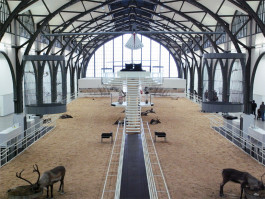
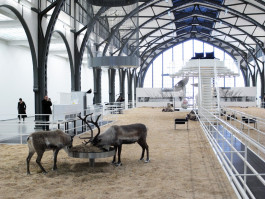
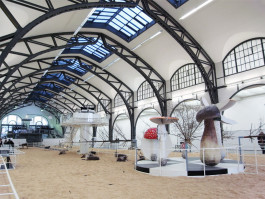
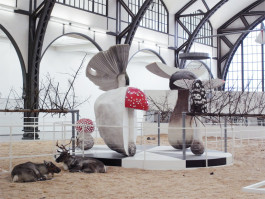
Freeze cubes within a laboratory setting, refridgerating fly agaric mushrooms and
reindeer urine
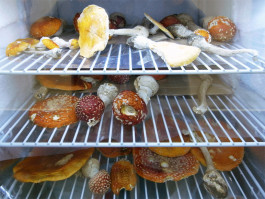
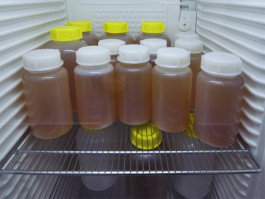
Tools for mixing and concocting soma
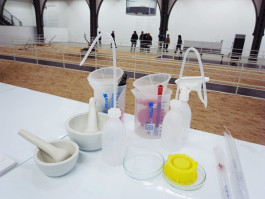
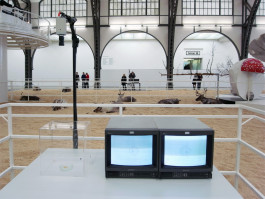
Related Projects

INS 027 SOMA Carsten Höller 2010
Header image: Hamburger Bahnhof, Berlin © DAPD, Maja Hitij
Text I: Hamburger Bahnhof Berlin, Text II: designboom
How do we achieve enlightenment? What role is science given in our society, and what role myth? Do we need to find alternative categories for experience and alternative approaches to awakening consciousness? These questions are all raised by the artist Carsten Höller in his show in the Hamburger Bahnhof, Museum für Gegenwart Berlin.
As one enters the former railway station, they are greeted by the sounds of singing canaries, whose songs fill the hall, the faint smell of farm stables lingering in the air. These sensory impressions, hardly what one would expect within a museum space, create a fantastical scenario that will slowly unfold over the course of the winter months. Set against this backdrop, Höller has devised a scene that stands at the crossroads between art and science, laboratory and dream, supposed objectivity and heightened subjectivity…
Within the exhibition, Höller explores the myth of "soma" — a drink with healing properties known among verdic nomads in north India in the second millennium BCE that promised enlightenment and access to the divine sphere. Commonly used in rituals, the drink’s main ingredient is no longer exactly known to us; ethnomycologists and philologists generally posit the fly amanita mushroom (Amanita muscaria) as the substance responsible for its effects. In 1968, Gordon R. Wasson, American wall street banker by profession with a passion for mycology, published a compendium, citing the fly amanita mushroom as the sought-after soma plant.
The protagonists of the scene include twelve reindeer, twenty-four canaries, eight mice and two flies, each ready to enact a comparative study between the normal world and the realm of soma which is to be administered to one of the two halves. It is a hypothetical experiment, whose completion not only lies within the viewers imagination, but those whose evaluation depends entirely on the viewers own powers of observation.

All following images © designboom




Freeze cubes within a laboratory setting, refridgerating fly agaric mushrooms and reindeer urine


Tools for mixing and concocting soma

Related Projects

